Episode 206: Workflow Actions you may not know about
Welcome to HubShots Episode 206: Workflow Actions you may not know about This episode we discuss workflow actions, starting with the new workflow...
If you're new to HubSpot, we guide you on where to start, how to do it right, and train you to make the most of the platform.
Review your HubSpot portal to uncover issues, spot growth opportunities, and ensure you're maximising its potential.
Unlock business growth with automation and attribution. Implement best practices and execute marketing campaigns.
HubSpot On-Demand
HubSpot Training
HubSpot Websites
HubSpot Campaigns
Virtual HubSpot Manager
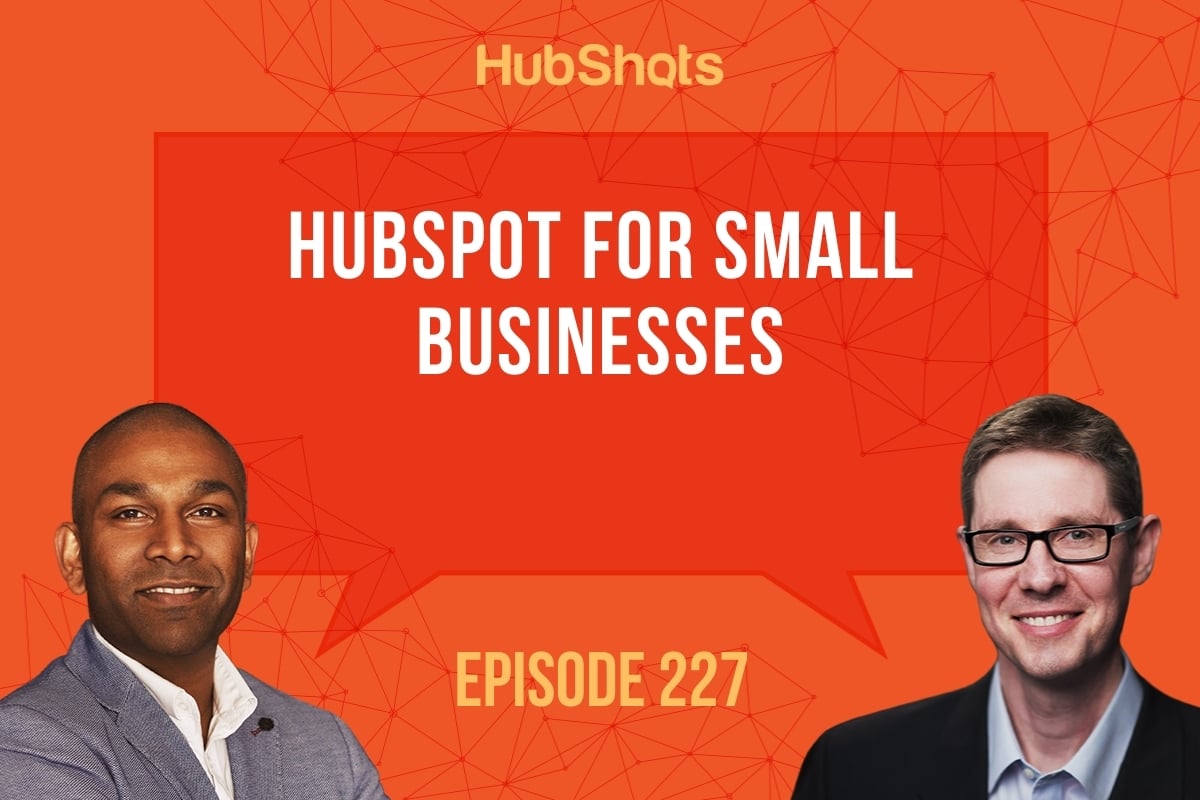
This edition we dive into:
You can listen to this episode of the show here.
Did a colleague forward this episode to you? Sign up here to get yours every Friday.
Please forward this on to your work colleagues.
Recorded: Monday 09 November 2020 | Published: Friday 13 November 2020
Here’s a quick cheat sheet of how to get started with HubSpot:
We’ll be discussing what you can do with HubSpot Starter.
If you don’t have time to do this yourself and would like our help, drop us a line.
If your site is a WordPress site you can easily use the HubSpot WordPress plugin to connect with HubSpot.
If you have other website systems (eg Drupal, Shopify), you can insert via the script into the site (or even better, use Google Tag Manager).
HubSpot tracks visitors to your site and shows all their interactions in the contact timeline, giving you powerful insight into what they are interested in.
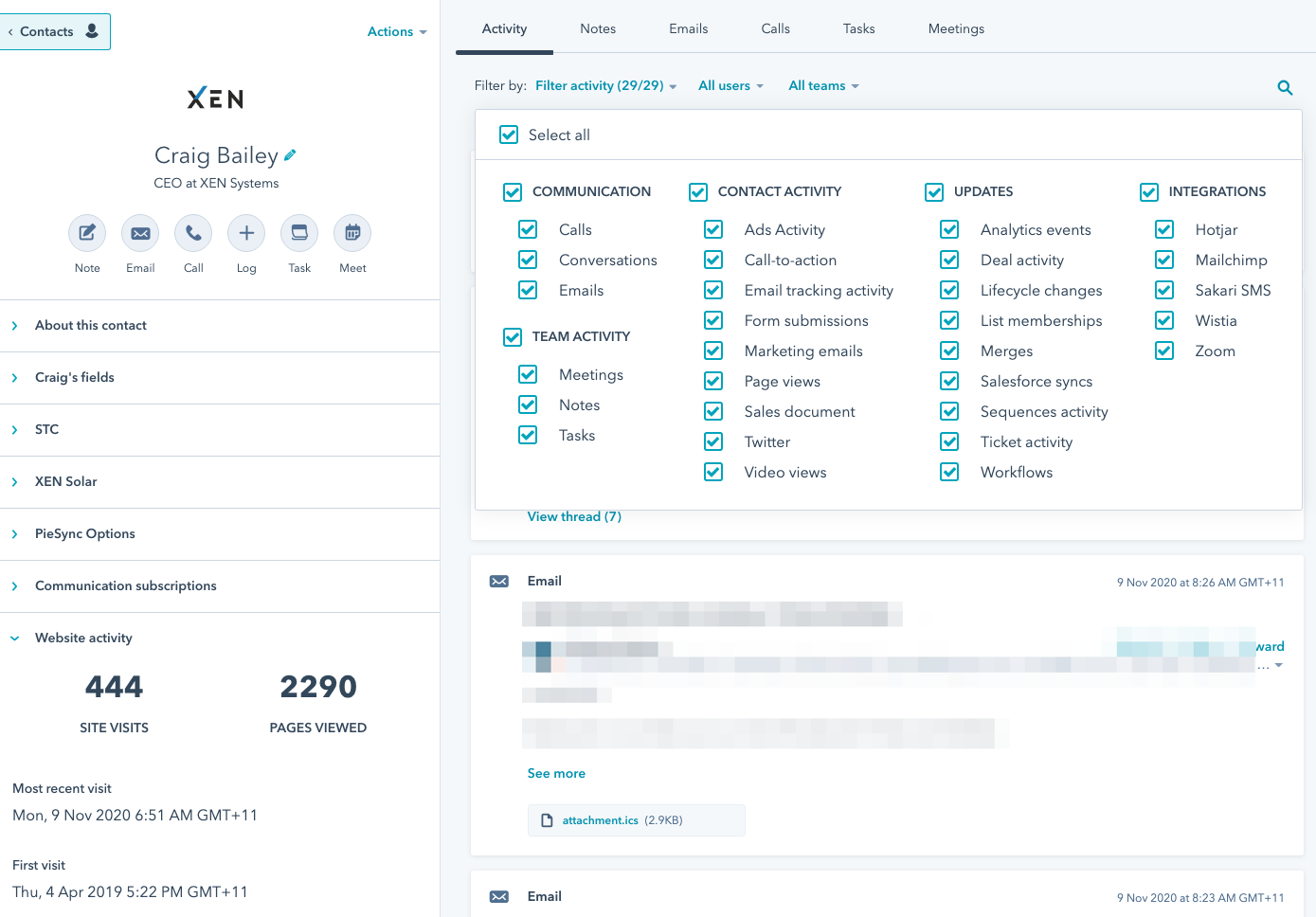
Popup forms are simple to build and great for collecting leads.
We recommend building popup forms that slide in from the left hand side after a delay of 7 seconds. The reason to slide in on the left hand side is due to many sites having chat windows that popup on the right.
Start with a simple Newsletter sign up form, but then aim to add more specific forms when you have time. The more specific the form, the more effective they will be. You can listen to episode 226 for our discussion on what conversion rates to expect from your forms.
By targeting a specific page with a specific offer you can usually get conversion rates higher than 10%:
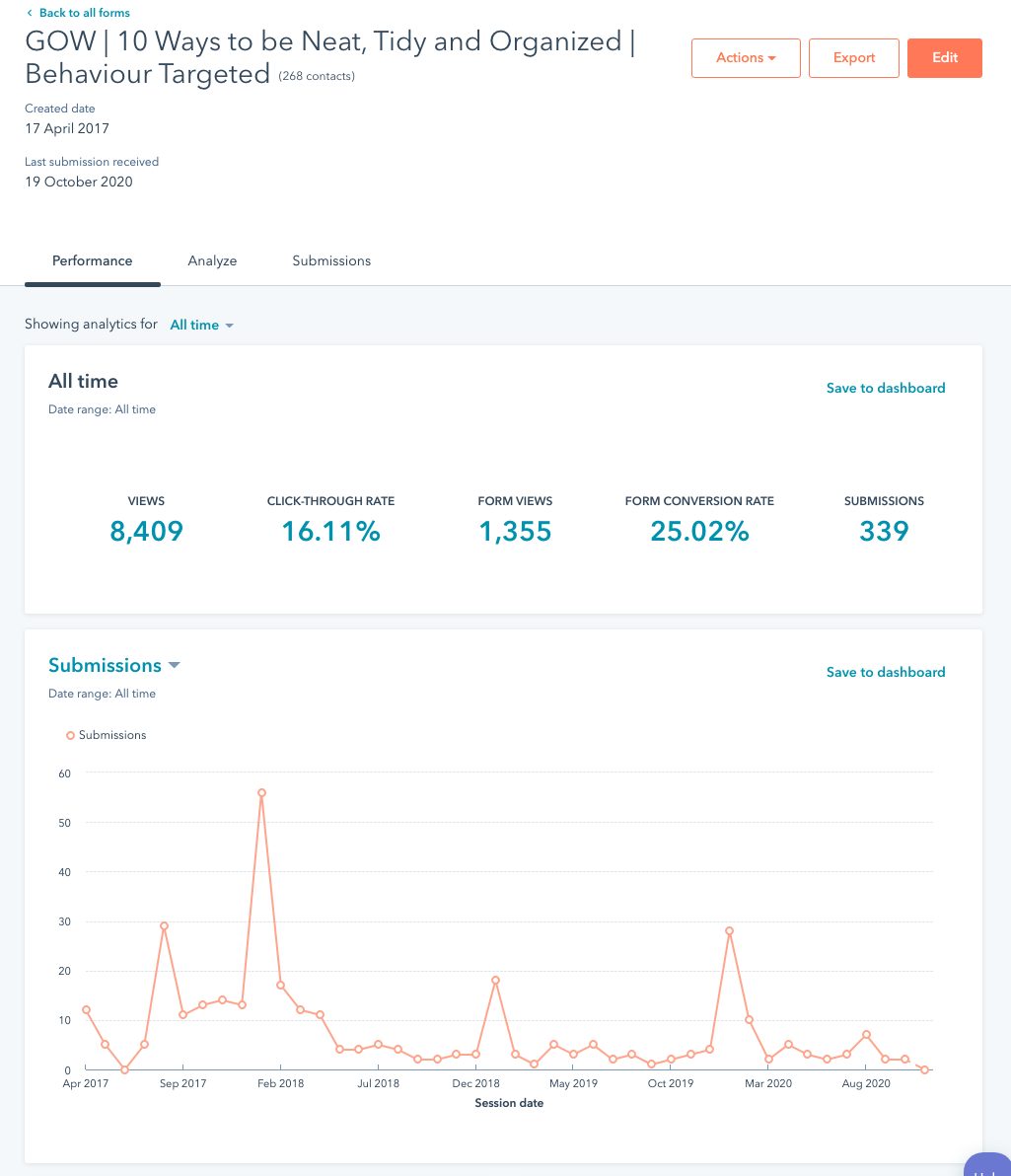
If you are using Google Ads, LinkedIn Ads or Facebook/Instagram ads, you can connect your ad accounts into HubSpot.
After connecting to HubSpot you can automatically insert the LI or FB pixels in your site.

Plus you can sync over your contact lists as audiences in the ad platforms - great for remarketing.
Plus you can automatically insert contacts from LinkedIn and Facebook lead forms.
You can easily import contacts via imports from CSV or Excel lists.
Make sure you also import any opt-out lists.
You can also use tools such as PieSync and Zapier to import contacts from other systems.
If you’ve got custom data points in your import files, you can setup custom properties on contacts and import into them.
Here is a good blog post from HubSpot about using custom properties.
Check the validity of your contacts using NeverBounce, especially if you have not communicated with them for over 6 months. You can then easily exclude bounces contacts from your future email campaigns.
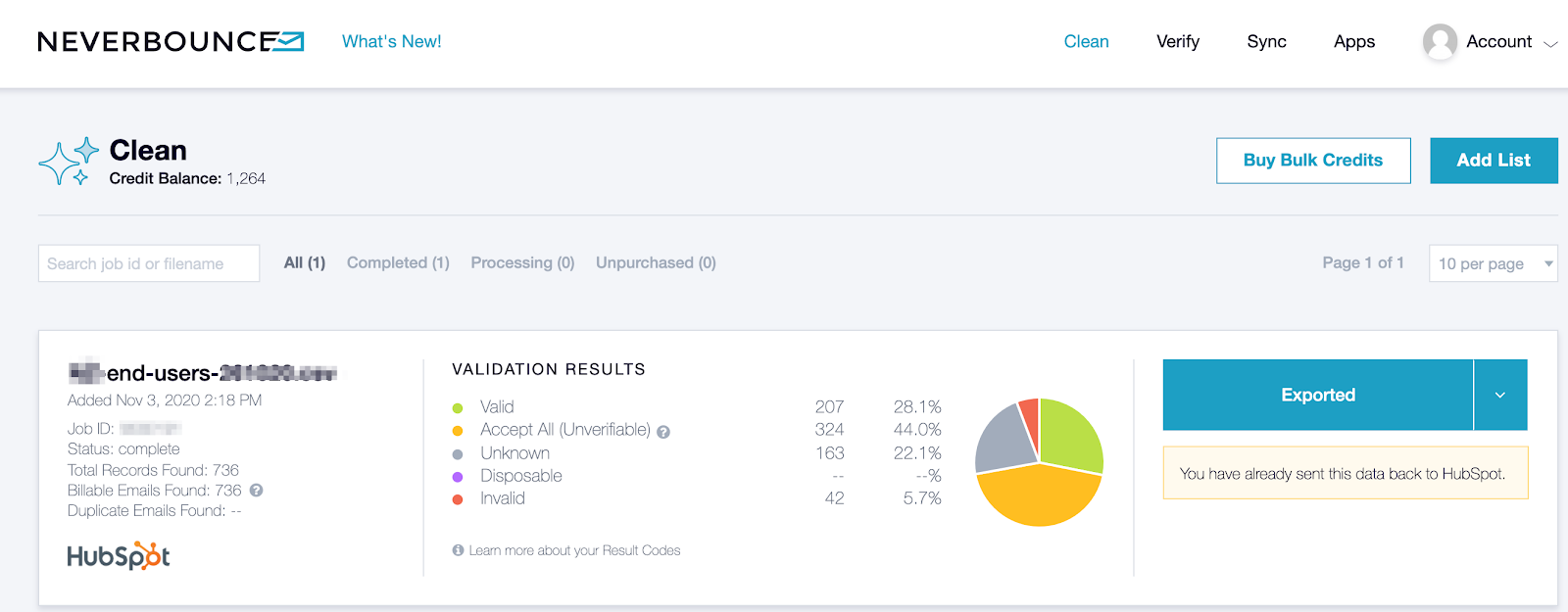
There is a default sales pipeline in HubSpot. We would encourage you to run with this if you don’t have one already. However, if you have a defined process you want to replicate you can edit this to match your process.

A good resource to start with is the Inbound Sales Course: Get Certified in Inbound Sales
Pro Tip: When creating deals you should do it from the contact so you can save time by having the ability to include history from the contact/company on the deal.
Email marketing in HubSpot is simple to setup and build:
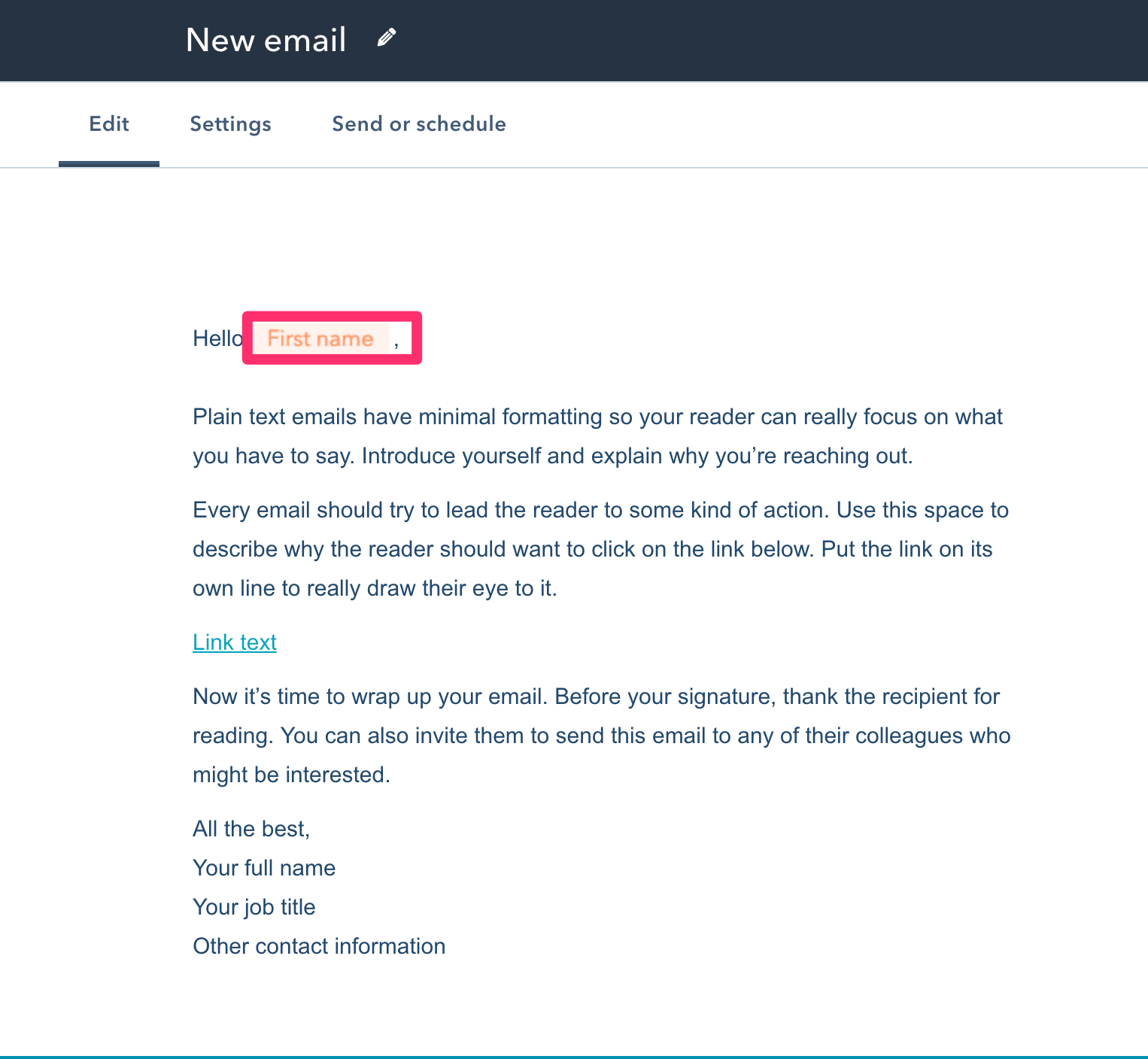
HubSpot makes it easy to connect your Gmail or Office 365 account.
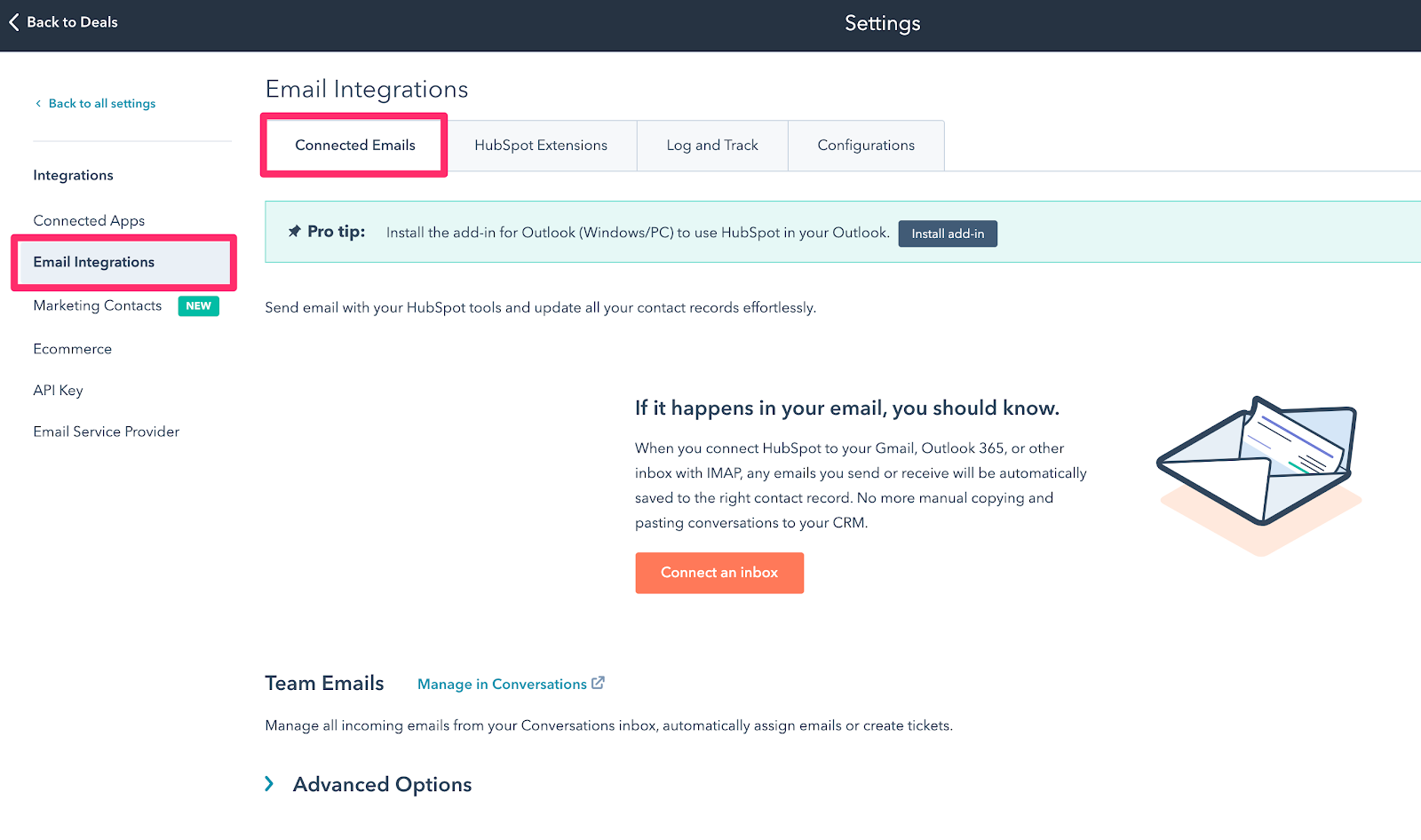
One thing people often forget is to never log internal domains on their account:
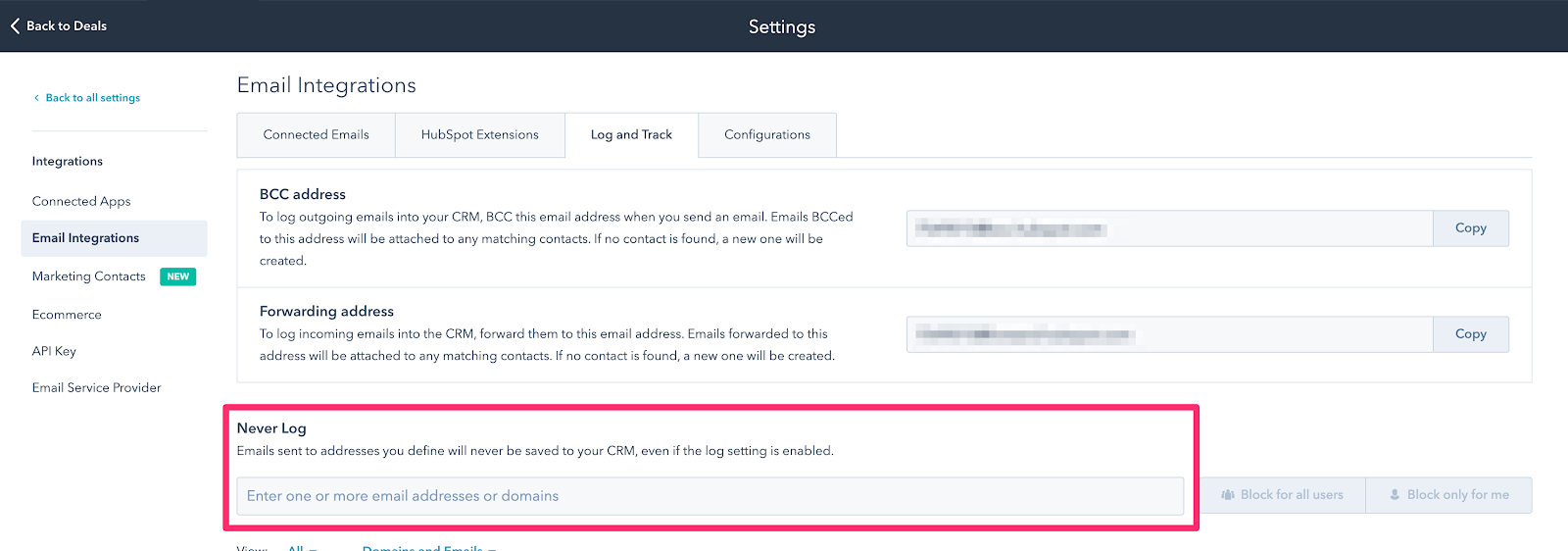
Build your personas here with the Persona Tool from HubSpot.
Use the HubSpot Academy courses to deepen your skills.
Look at the Dashboard Library to setup your reporting so you know what is going on! Here is how to get started with reports.
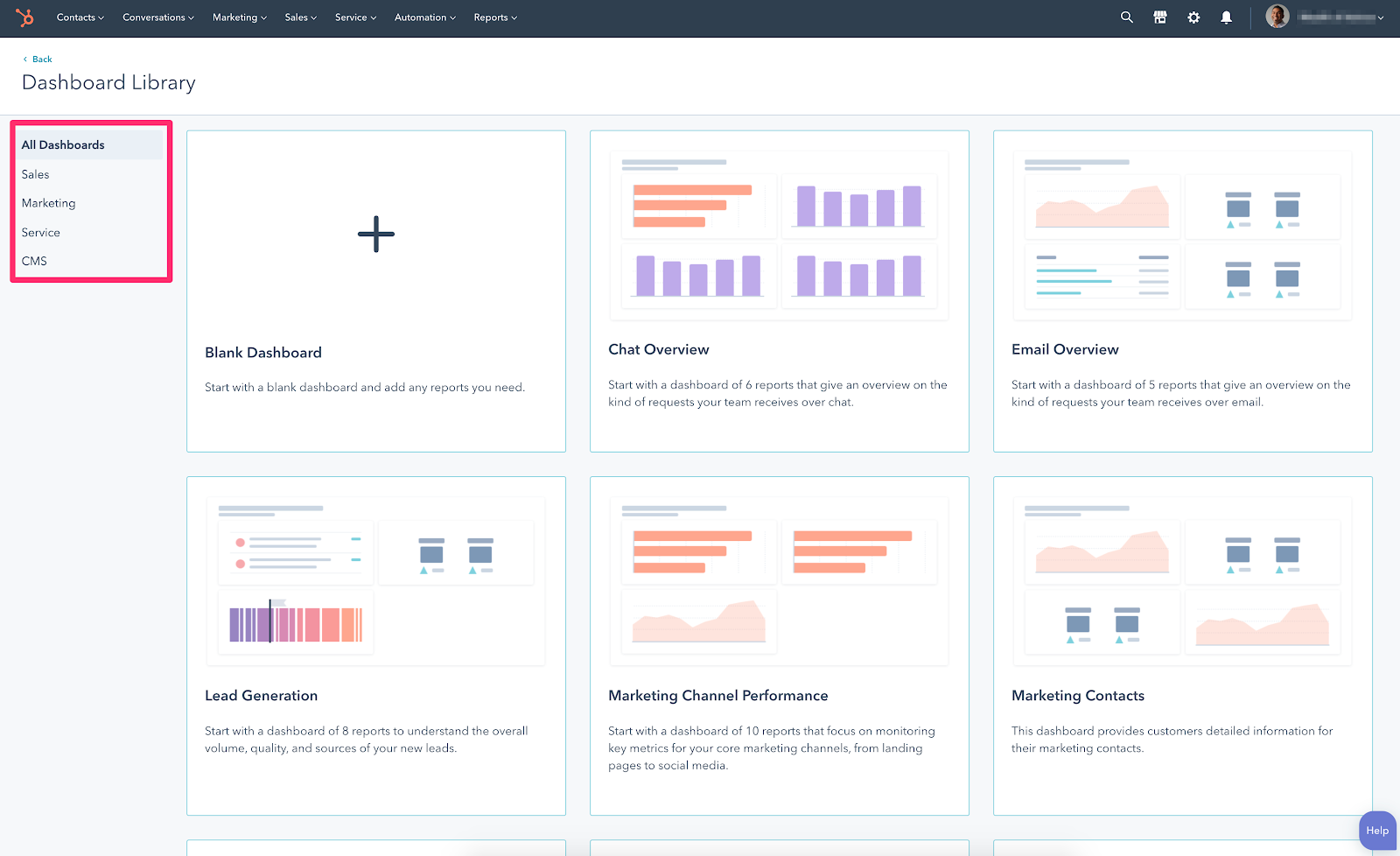
Pro Tip: Setup your Dashboard to be emailed to yourself or others on your team so you have a great starting point for the week.
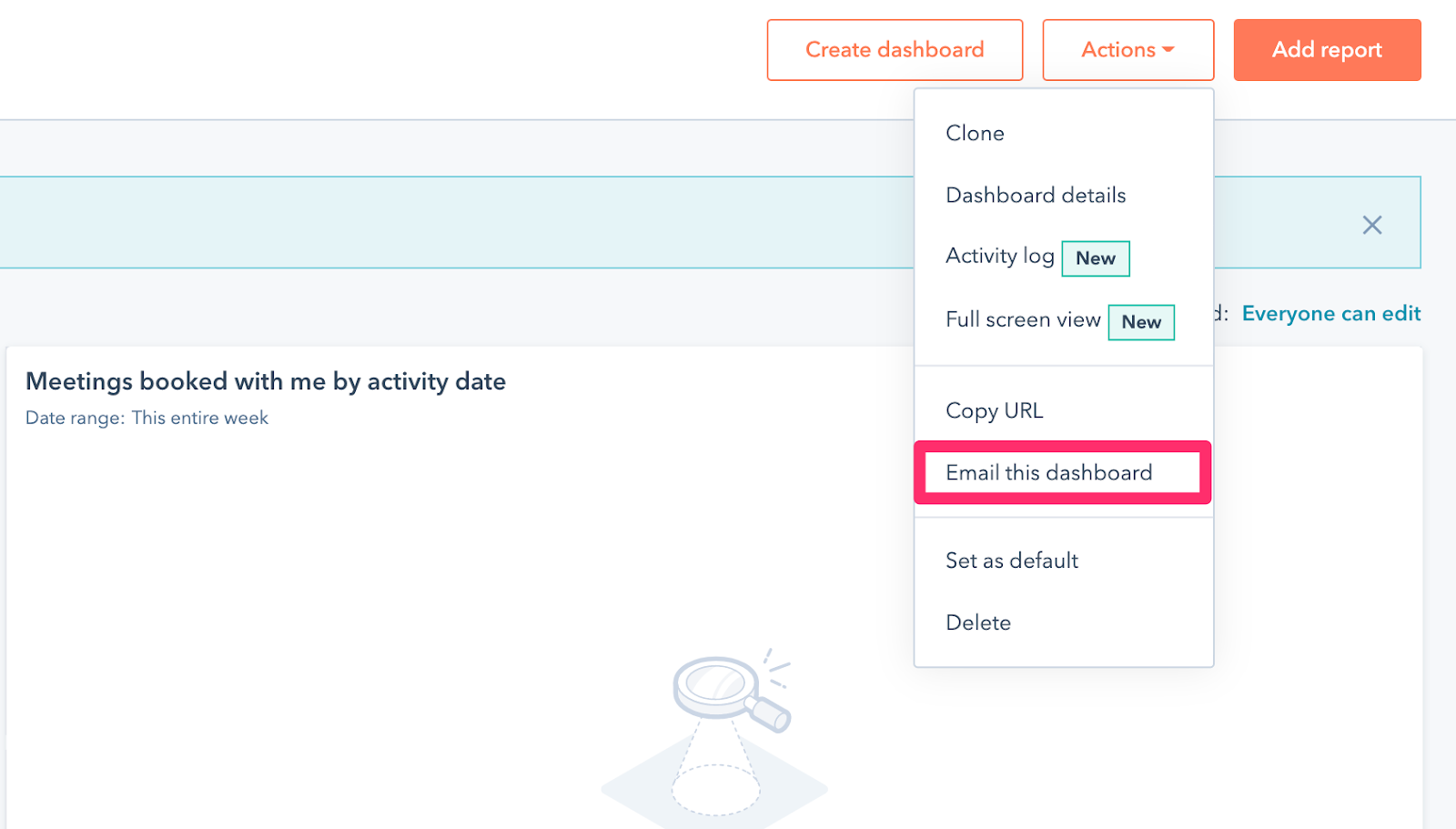
“The Bible tells us that to everything there is a season — a time to build, a time to reap, a time to sow. And a time to heal.
This is the time to heal in America.”
Connect with HubShots here:
Connect with Ian Jacob on LinkedIn and Craig Bailey on LinkedIn
HubShots, the podcast for marketing managers and sales professionals who use HubSpot, hosted by Ian Jacob from Search & Be Found and Craig Bailey from XEN Systems.
HubShots is produced by Christopher Mottram from Podcastily.
Please share this with colleagues - it helps us improve and reach more marketers.
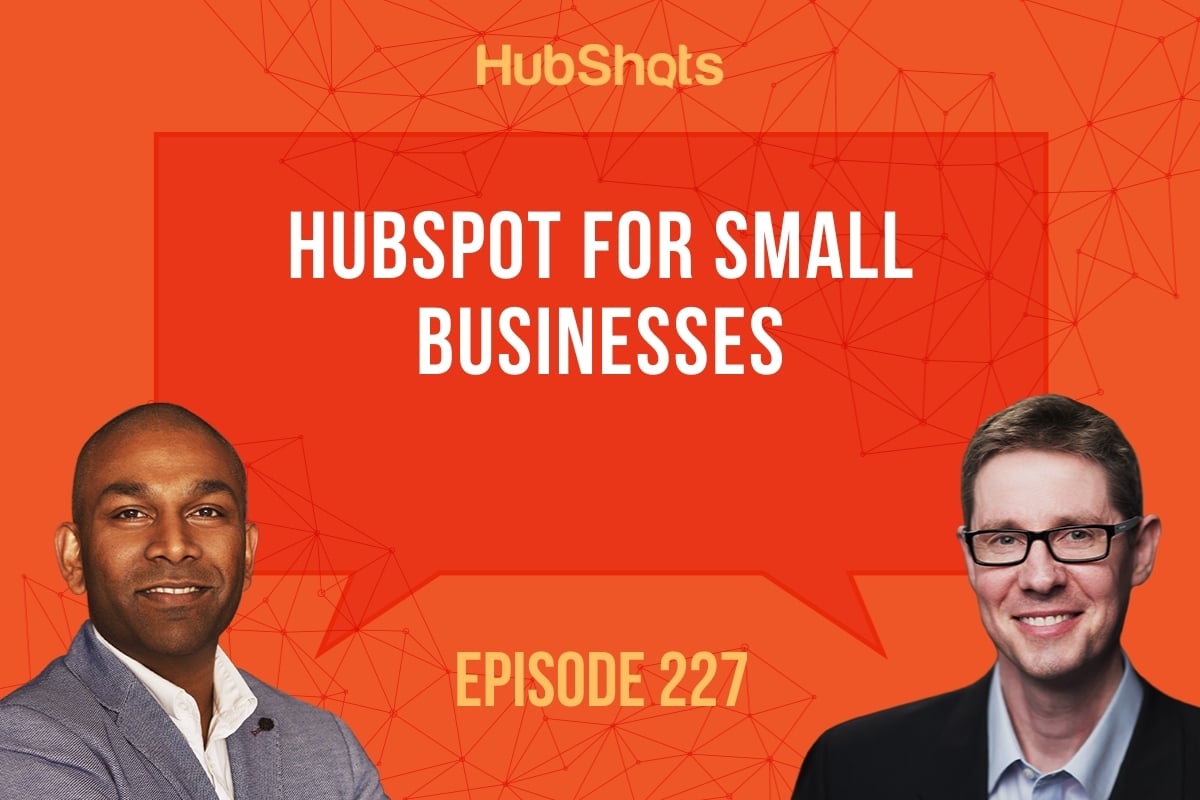
- Hi everyone. Welcome to "HubShots" episode 227. In this episode we discuss about using HubSpot for small businesses. And in this edition we will dive into how to use it and set it up correctly. The top priority items to focus on, the key integration you must enable and tips for getting the most out of HubSpot in the first month. You're listening to Asia Pacific's number one HubSpot focus podcast where we discuss HubSpot tips, tricks and strategies for growing your sales, service and marketing results. My name is Ian Jacob from Search & Be Found and with me is Craig Bailey from XEN Systems. How are you Craig?
- Ian, I am so relieved. That's all I'm gonna say. Listeners, we're recording this on Monday the 9th of November, 2020 and I'm sure you know what the significance of that date is after a nail biting week last week, that's all I'm gonna say. I'm very relieved. And today, yeah, chatting about prioritizing for small businesses you said, I think the point to make though is even if you're in a large enterprise, this is still gonna be valuable 'cause we give you our checklist of things to set up and prioritize first. And if you've been running a HubSpot for a while and you still haven't done some of these then here's a nice, healthy reminder to get these in place.
- All right, so starting with that, we wanted to prioritize stuff and I'm just gonna quickly go through what those priorities are and then we're gonna move through each one. So I encourage you, even people that are using Sales Professional or any other sales tools, look at this because there's a really good place to start. So the first thing we're gonna talk about, Craig, is connecting HubSpot to your website.
- Yeah, well, we'll dive into the details in a second, but actually let's just go through. There's really only seven items on our list. This is the cheat sheet. So what's the cheat sheet? The first one is connect to your website with HubSpot. What's the next one?
- Adding a pop up form.
- Then we're gonna add out ad accounts and pixels.
- Then you're gonna import your contacts.
- Then you're gonna prepare an email campaign.
- Then you're gonna set up your sales pipeline.
- And then finally, you're gonna connect your email tool whether that's Gmail or Outlook Office 365 to HubSpot for tracking all those one-to-one emails. So yeah, let's get into it.
- And Craig, there is a bonus, there is a bonus. The bonus one is to set up your dashboards.
- Oh, good bonus as well.
- We will add that in, but that's what we're gonna talk about. All right, so let's start with the first one, which is connecting it to your website. Now, this is where I say, even if you're using Sales Professional, using the sales tools, you need to connect it to your website. It's not hard. And there is a WordPress plugin to do that. So we would encourage you, the other ways to use it, do it using Google Tag Manager. So these are the two ways you can do it. But what this enables you to do is get powerful insights into users that are using your site and what they do even to the point of revisiting your site which people often forget, this can happen. And another thing on top of that is, there's a prospects tool within HubSpot. Having this clenched to your site you can see who is coming to your site that you don't know about, but might be able to identify the company. So this is really great for large organizations that are doing especially account-based marketing to get this data.
- I think this is right, and this can often be overlooked. The power of HubSpot in the context timeline cannot be overstated. It is so powerful and such a rich source of insight. And although most companies, I think, that have had HubSpot for a while, do this, get this connected in place. Where we often see them miss is when they have multiple sites or sub sites or perhaps even an application site or their checkout. Their E-commerce site is on another site. And they forget to put the HubSpot tracking on all of their websites. So don't make that mistake and miss out on the insights and make sure HubSpot is connected to your website.
- All right, the next thing we would encourage people to do is add a pop-up form. And if you've been listening to us for any amount of time you would know how well these work and what a great tool this is within HubSpot. And it's just a fantastic way to collect leads easily and change and iterate and see what's working. So we encourage people to do that. And building a pop-up form generally comes in after seven seconds. The ones we love are the ones that slide in from the left hand side on many sides. So it's very unobtrusive and why we're saying the left because sometimes you might have chat windows pop up on the right. So what's another good way to have a popup form, Craig?
- Oh, by being specific, you mean?
- Correct.
- We always say to people, just start with a simple offer, a newsletter, don't expect amazing conversion rates but at least get something on your site. But then as time allows quickly get a specific offer on specific pages, choose your highest visited page, create an offer that's specific to that page and put the pop-up form, targeting that page. You can easily get conversion rates higher than 10% just by being more specific.
- Here's a little tip which I haven't stuck in the show notes, but one of the things you can do, if you realize people are stuck on a page where they have to make a choice, a really good place is, they're fed a page, that's a category page and they don't really know what product or category they're going into, one thing that's worked quite well is having a pop-up that comes from the top that slides down that says, do you need help choosing? And we've implemented that with a couple of clients and that works really well. So that's another pop-up that you can implement very easily to get people engaged, engage them before they get lost. And another thing that I wanted to highlight with having these forms is the data you can get and understand how they're working over time. And this is all a part of reporting and understanding. We discussed this in last episode, 226, about the importance of reviewing the analytics in forms. And this is just such a good way of doing it, isn't it Craig?
- Yeah, it is. Here's the secret sauce of pop-up forms. Make them specific to the page with a specific offer and review the analytics to see what's working and what's not. And we do dive into that in detail in our previous episode 226, as you mentioned.
- All right, and the fourth thing you should do, is connect your add accounts. And why we say asking people to do this is most people have Facebook add accounts and have Google add accounts. And even if you don't, I would encourage you to set it up and install the pixel, which is the tracking code. And you can do this from within HubSpot quite easily just to collect the data. And that is one of the biggest things that we tell people, is that collect the data so that when you're ready to use it, you have the right data, isn't that right, Craig?
- Yeah, that's right. And that's also why we, in our very first shot, we talked about connecting your website with HubSpot because once you have HubSpot connected to your website, then this shot connecting your add accounts is easy. You just connect your Facebook account to HubSpot and then click it to automatically insert that pixel in your site. No extra coding, no other mucking around, it just makes it really easy. And as he then mentioned, we can report on it. So you're getting a data but you can also then sync back your contact lists to those platforms so that you can do retargeting. HubSpot just makes it so easy, get it in place, and then you can use it later.
- Now, listen, as we haven't mentioned directly but when you add your Facebook add account and your Facebook page, what this enables you to do is if you collect leads off Facebook, the data will come in directly into HubSpot. And a lot of people miss this as a really key thing that can be done without double handling data and forms. So I encourage you in its really simplest form, cook this in, it has a massive benefit to your business. All right, the next thing we wanna talk about, Craig, is importing contacts.
- Yes, this is another simple way to get up to speed, especially when you're thinking more about the sales side of things, using the CRM functionality in HubSpot, import your contacts, but a few little tips and tricks in terms of importing them. Now you probably would guess that you can import your contacts via CSV or Excel. And by the way, worth mentioning to listeners that we've put links to all of these knowledge base articles and HubSpot Academy courses in the show notes. So if you do wanna dive into these in a little bit better and just check out the show notes and you'll get the links to visit. Once you've started importing from Excel let's say, then the next thing need to make sure is if you've been using a previous systems, I used MailChimp in the past, import any opt out lists so that you don't go sending off emails to people who have previously unsubscribed. We've got a link for that. And then you can also easily import from other systems using PieSync or Zapier, very easy to connect these and sync over your contacts from other systems. Now what if you need a little bit of flexibility, what if you've got other data in your systems, what would you do then, Ian?
- So this is where we would recommend setting up custom properties in the contact records and possibly even deal records. But firstly, contact records, Craig, it's very easy to do. And there is a great resource in the HubSpot knowledge base and the Academy on how to do this.
- And then you've, let's say you've got all your contacts in, you've got your opt-out lists. What's the final important thing we do before we wanna be starting to send out a contacts, Ian?
- We wanna validate the contacts, Craig, and we use or have used over time, a system called NeverBounce. And we would encourage this because of the attrition rate of contacts, I think is it, was it 25% every year? If you haven't communicated with them, it is best to validate them. And you can exclude bounce contacts or ones that can't be out of campaigns because, listeners, don't make the mistakes we have made and get customer lists of contacts that are potentially older than a year, load them in and try to email, and you will have a high bounce rate and you don't want to get stuck in that situation. So this is why this step is super important when you are importing your contacts and validating them.
- Yeah, what this is, I'll just explain it in case you've never heard or NeverBounce. It's a third party tool. You connect it to your HubSpot account, a little integration, and then it checks all your contacts and it gives you a little writing. It says, oh, this contact is gonna bounce. We know, cause they've got this massive database. They know, oh, this email address that you've got no longer exists, it would bounce. So it gives you that warning so that you can exclude it. So very handy tool and a must do in terms of what we recommend.
- And listeners, as you can sign up and do a quick validation in their account without any credit, and then you can pay to get it actually validated fully. And what I do like about it is it's not super expensive so it's well worth the money to make sure your data is clean. All right, the next thing we're gonna talk about is setting up your sales pipeline, and there is a default pipeline in HubSpot and we encourage you to run with that if you don't have a process already. However, if you do have a process, I would encourage you to set that up in HubSpot to mimic your sales process and why this is important is that it'll help you get a better understanding of how things are moving through the sales process and keep it simple. So over time, if you do a weekly review of your sales, you'll understand that there are certain stages that might be skipped or that become invalid or maybe you're missing a stage that should be there because things are getting stuck in a particular location. It helps you uncover this, but keep a track of things because I know for a fact when we work with lots of people, it's so easy to forget stuff because you get inquiries from all these different sources, you get referrals, you get people inquiring of your website. You get people calling you, you get people referring you on Facebook and then you kind of lose track of where everything is. And this is a really good place to make sure that you don't lose anything.
- So we've set up the website, we've connected accounts add accounts, we've imported our contacts. We validated them. Now you've got your sales pipeline. So for many businesses, this is a massive shift from where they've been working previously and spreadsheets and all kinds of lists or something kept in Outlook. You've now got it all in HubSpot, you're tracking, you're tracking deals now, it's very easy to do. For many people that's almost a revolution in their business, but then from the marketing side, then you come to sending your first HubSpot campaign.
- That's right, Craig, but before I go on, I wanna have a, I had a little pro tip with the deal creation. And one of the things I wanted to say is when you're creating a deal, create it from the contact because the deal's usually associated with a person and a company, generally. If you create it from the contact, you'll have the ability to associate or draw in history from the contact or the company into the deal in the one place when you're creating it. Now, if you create the deal, you won't have that ability to do that. So that's why I tell people, this is a great way to create the deal when you first start. Now onto our first email campaign, Craig. And this is where the rubber hits road.
- This is it, well, from the marketing side, and you know, from just the sales perspective what we've talked about and set up, for many sales that they don't need that, they're not even using HubSpot to send out email campaigns, but here's the next level. You've got all that set up. You've got the contacts in there. They've been cleansed. They're now tracking. They may be getting contact from your sales team. Now you send out the email campaign. It's so simple to set up your first one in HubSpot. Again, we've linked it in the show notes but you almost don't even need knowledge base just in HubSpot, go to email, create, choose one of their built-in templates. It's even got a little bit of personalization, pulls in their first name. Just write it, super easy to use editor, work out the recipients it's going to in your database and you can send it out. Make sure you've got a link or two in the email and you're tracking. And that's your first campaign out driving people back to your business, building and growing your company.
- And listeners one tip is to make sure you use a simple template to start off with, just to make sure you can maximize your delivery and open rates. So we encourage businesses to use that in the first instance before you start sending more elaborate marketing emails.
- Have you got any initial tips for how you would write the first email, Ian?
- Yes, Craig. So because I always say it's coming from one person. Think about who you're writing this to and write it just like you would write to that person that you're communicating with. I often find people think, oh, it's a marketing email. I'm gonna put my marketing hat on and write this. And so they almost become very impersonal. And what we've really gone back to is being personal and connecting with that person in a way that's natural to them. Number eight, Craig, is about connecting your email client to HubSpot. Now users just be aware, this is something that has to be done on a per user basis. And it's not that hard. It is a little bit of a process, but it's well worth the effort, isn't it, Craig?
- It is worth it because it means from Outlook or Gmail, whenever you send an email to a person, you can just click the log to HubSpot and you can also track it. Records all that data, all that email correspondence straight within HubSpot, so you can see it in the timeline. Now you might wonder, well, why didn't we say this right at the start? Why have we left this towards the end? The reason is because as you said, Ian, there are a couple of steps and it is personal. So each person needs to do this. So quite often people get tripped up. So we don't, we don't actually tell people to do this at the start because otherwise they kind of get caught on it and they don't realize they can go on with all the other items. So when you've got everything else in place, do this, connect it, it just adds that whole dimension of the complete relationship you have with that contact into HubSpot. And you can drill it for insights.
- That's right, so users, here, you don't have to always tell it to log activity against a contact, where you can set it up to automatically do that when you email the person. One thing people often ask us is if somebody emails me and they're in my HubSpot CRM, will that get logged against them? And no, they don't because there's no initial tracking but there is the ability for you to forward on to the CRM of that email, or if you reply to that email, it will get logged into the CRM in that instance. The next tip I wanted to tell you about is that people often forget is internally to your organization, you might want to never log emails for your business into HubSpot CRM. And I tell you this because people email things about personal things to do with performance and things within the business that potentially other people will read. So exclude your company domain as one. And I always say, exclude your mum or your partner as another one, because you might actually end to find out that your email to them ends up in HubSpot. And there is another bonus from this, Craig, once you've connected your inbox you can also use the task feature within Gmail in your Gmail inbox. And this is something that's been released recently.
- Yep, that's another pro tip right there.
- All right, onto shot nine, Craig, and we're talking about who we're actually marketing to and we almost should have included this a little bit earlier but let's, let's say that we've now done all of this setup. We want to understand our customer better. And what we've done is we've linked to the persona tool from HubSpot. And there's an Academy course about understanding who we're marketing to. So listeners, I encourage you to look at it, go and build out your persona, because understanding who you're talking to can make a massive difference in the conversion of your forms, your emails and everything you do on your website and even in your sales process. The better you can understand them, the better you will get a result.
- I think that's right, and what we've tried to do in all the shots prior to this, we're talking about implementation piece. When we come to this tip, persona, that's when we're starting to talk about strategy and we can do a whole other episode on strategy for small businesses, but the personas is just the start. And I think this HubSpot Academy course introduces the topic well, so worth reviewing and just starting to think about how you segment and consider your different customer behaviors and aspects.
- And finally, Craig, we want to look at a reporting and the very simplest thing you can do is to go and look at the dashboard library and set up reporting, so, you know, what's going on and get started with the standard dashboards. And they've got everything from sales dashboards, marketing dashboards, email dashboards, choose one. I would recommend try as many as you like, see what one works and then shuffle things around. Don't be afraid to try this out.
- And you've got a pro tip here about setting up the dashboard to be emailed to yourself. And you can set this up on a schedule, work out your dashboard and then automatically have it sent out to members of the team. We do this for a lot of clients. It's first thing, Monday morning, it gets sent out. They know what the previous week was like, and they can be planning for the week ahead.
- That's right, it's a great way to get the team refocused.
- All right, so a whole bunch of tips there. I think it's a really straightforward and I guess for us saying it, it does seem easy but worth mentioning to listeners. If this is the kind of thing you're interested in, but you just don't have the time to set it up, we do this day in day out for our clients. If you need a bit of help, fill out the form on the site, get in contact with us, we'll be happy to jump on a Zoom call and help you out depending on your complexity, very economical. We can get you up and running very quickly.
- Absolutely. And what's that code of the week, Craig?
- We're including this because it's timely. It's not related to marketing, but once I read it to you, I think you'll appreciate it. And this is a quote. I'll tell you who it's from first, it's from Joe Biden, it's from his address. And he simply said, the Bible tells us that to everything there is a season, a time to build, a time to reap, a time to sow and a time to heal. This is the time to heal in America. We'll just leave it there. I know there is a divided nation, many people won't like this quote, and many people will love this quote as the outsiders, we're not privy to what's going on. We don't feel the divide 'cause we're in Australia but we couldn't let this episode, recording it on Monday, the ninth go past without at least acknowledging that a significant thing has happened in global affairs.
- That's right. Listeners, thank you for listening to us. And we hope this episode has been useful to you. Please connect with Craig and myself on LinkedIn. Send us a note and say that you listen to the show. We love to hear from you. Follow us on YouTube, on Instagram, on Facebook, we're posting stuff and please direct message us. We would love to speak to you wherever you want to. And again, if you do need help, we do have help available that is a paid, and we will be happy to help anybody that listens to this show from partners to individuals, to other businesses. We love helping people. So please reach out to us. There is nothing that we would not like to do. So Craig, until next time.
- Catch you later, Ian.
- Hey there, thanks for listening to this episode of "HubShots". To get the latest show notes, HubSpot tips and resources, sign up at hubshots.com. You can also book time with us to help you grow better with HubSpot.
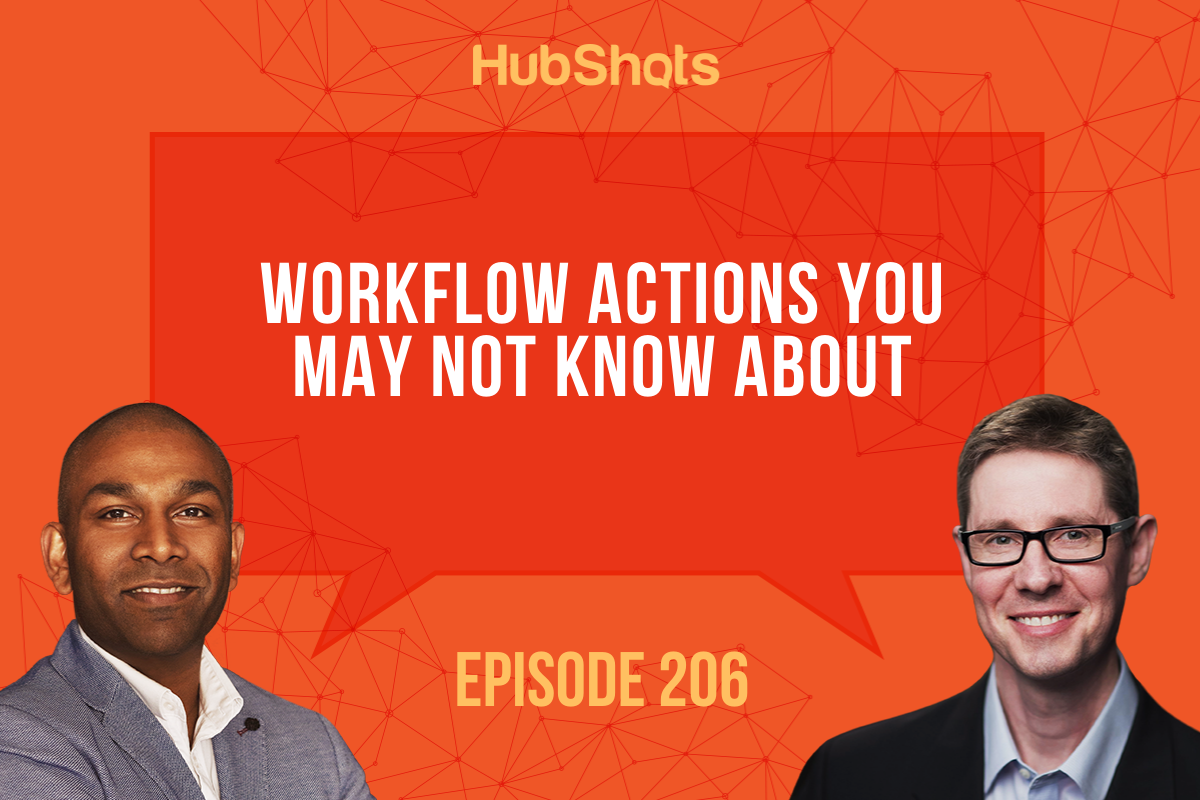
Welcome to HubShots Episode 206: Workflow Actions you may not know about This episode we discuss workflow actions, starting with the new workflow...
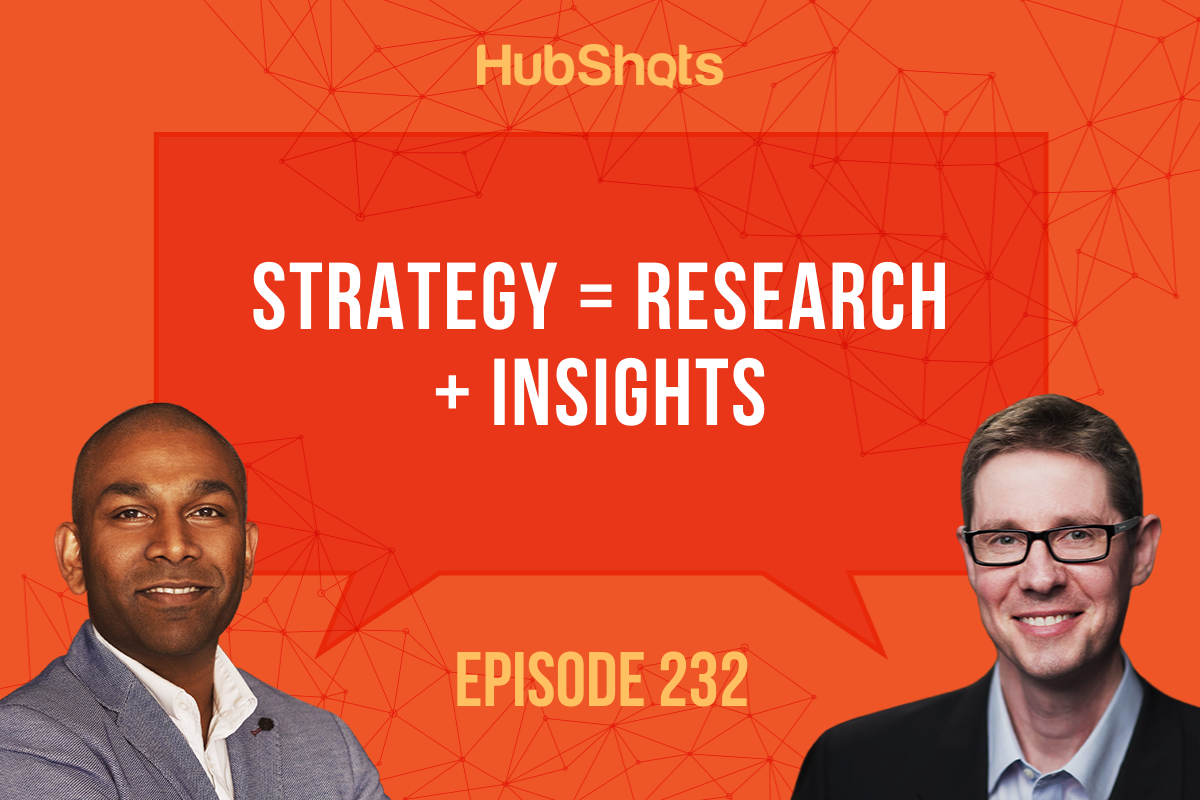
Welcome to HubShots Episode 232: Strategy = Research + Insights
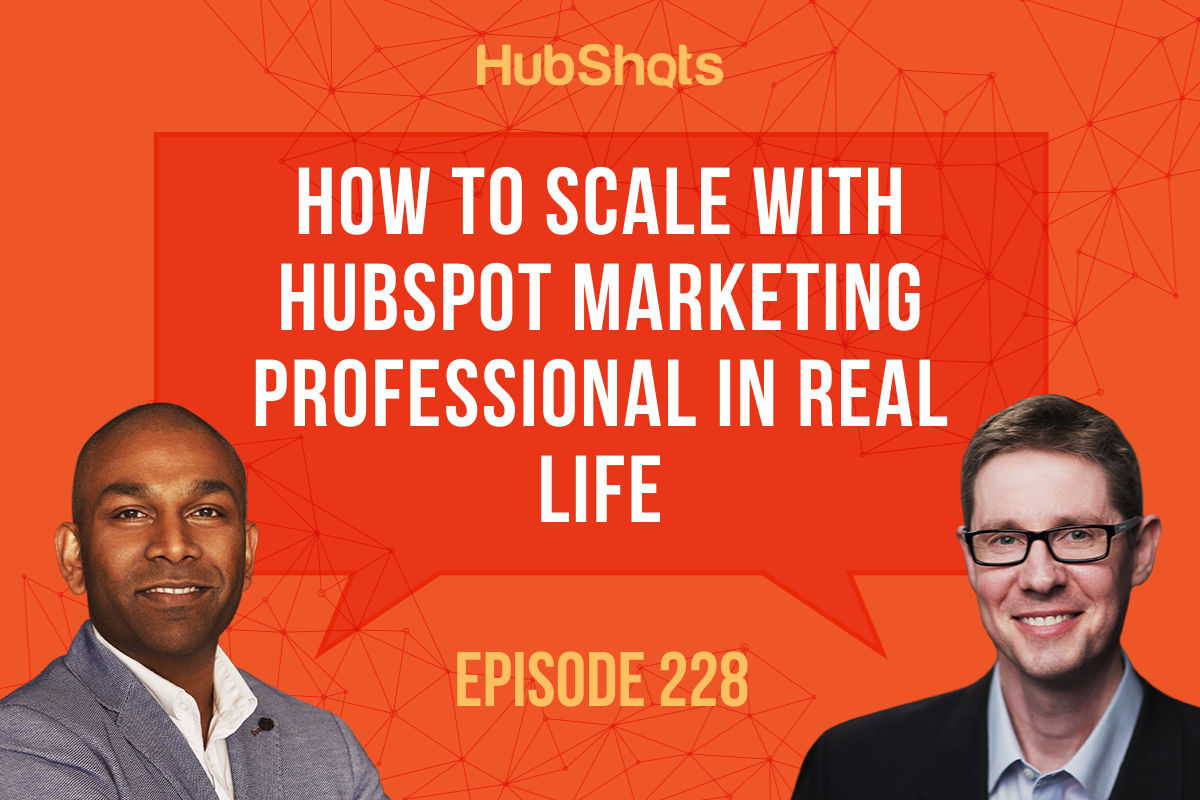
Welcome to HubShots Episode 228: How To Scale with HubSpot Marketing Professional In Real Life